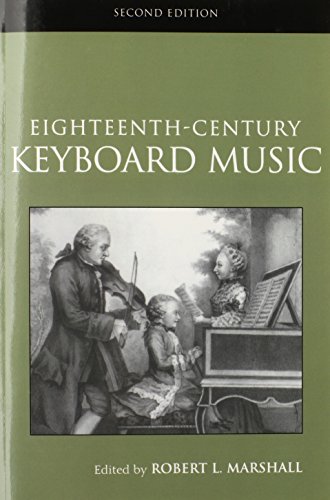

Most ebook files are in PDF format, so you can easily read them using various software such as Foxit Reader or directly on the Google Chrome browser.
Some ebook files are released by publishers in other formats such as .awz, .mobi, .epub, .fb2, etc. You may need to install specific software to read these formats on mobile/PC, such as Calibre.
Please read the tutorial at this link. https://ebooknice.com/page/post?id=faq
We offer FREE conversion to the popular formats you request; however, this may take some time. Therefore, right after payment, please email us, and we will try to provide the service as quickly as possible.
For some exceptional file formats or broken links (if any), please refrain from opening any disputes. Instead, email us first, and we will try to assist within a maximum of 6 hours.
EbookNice Team

Status:
Available4.6
11 reviews
ISBN 10: 0415966426
ISBN 13: 9780415966429
Author: Robert Marshall
18th-Century Piano Music focuses on the core composers of the 18th century repertoire. The book begins with an overview of the keyboard instruments that were in use during the period, and a chapter on performance practice. Then, the book proceeds through each major composer, beginning with Bach, and then progressing through the French Masters, Scarlatti, C.P.E and J.C. Bach, Haydn, Mozart, and Early Beethoven.
Chapter One: the Instruments
Idioms and Instruments
Social Contexts
The Industry
Construction, Mechanisms, Ranges
The Harpsichord
The Clavichord
The Piano
The Organ
Carillons and Other Keyboard Instruments
Notes
Selected Bibliography
Chapter Two: Aspects of Performance Practice
Problems of Text and Notation
Tempo
Rhythm
Ornaments
Improvised Embellishments
Authenticity and “Original” Sound
Early Use of the Cembalo Con Martelli
Good Execution: Music as Language and Rhetoric
Notes
Selected Bibliograpky
Chapter Three: Johann Sebastian Each
The Repertoire
Bach’s Instruments
The First Decade, ca.1703–1713: Apprenticeship and Early Mastery
Preludes, Fantasias, Toccatas,and Fugues
The First Synthesis: 1713–1723
The Second Synthesis: Leipzig,1726–1741
The Final Decade
Notes
Significant Musical Editions and Facsimiles
Literature Cited and Selected Bibliography
Chapter Four: French Masters
Elements of the Style
The Keyboard Genres
After Mid-Century
Influence and Legacy
Notes
Selected Facsimile and Modern Editions
Literature Cited and Selected Bibliography
Chapter Five: Domenico Scarlatti
The Career
The Sources of the Scarlatti Sonatas
Scarlatti’s Instruments
Aspects of Performance Practice in Scarlatti
The Sources of Scarlatti’s Keyboard Style
The Structure of the Scarlatti Sonata
The Development of Scarlatti’s Style
Notes
Bibliography
Chapter Six: Carl Philipp Emanuel Each
Musical Editions
Bach’s Keyboard Style
Organization and Editions of Bach’s Keyboard Works
Bach’s Keyboard Works
Notes
Literature Cited and Selected Bibliography
Chapter Seven: Johann Christian Each and the Early Classical Italian Masters
The Repertory
Social Function, Social Status
The Founders of the Venetian Tradition: Marcello, Alberti
Early Classical Style
Contemporaries of Marcello and Alberti: Platti, Martini, and Others
Mid-Century Developments: Rutini, Galuppi
The Italian Keyboard Sonata Abroad
The Accompanied Sonata
Johann Ghristian Bach(1735–1782)
Notes
Literature Cited and Selected Bibliography
Chapter Eight: Haydn’s Solo Keyboard Music
The Early Works
The Late 1760s and Early 1770s
Three Sets of Six,1773–1780
The 1780s
The Last Works
Notes
Literature Cited and Selected Bibliography
Chapter Nine: Mozart’s Solo Keyboard Music
Compositional Fundamentals: Improvisation and Variation
Early Keyboard Compositions
Munich, 1775: Six Sonatas K.279–284
Mannheim and Paris, 1777–1778: Three Sonatas K.309–311
The Middle Period,1783–1784: Five Sonatas K.330–333,457, and the Fantasia K.475
The Threshold to the Late Period: Three Rondos K.485,494,511
The Late Piano Compositions: Four Sonatas K.533,545,570,576, and the Adagio K.540
The Duo-Piano Works
Impact
Epilogue: Practical Issues
Notes
Selected Bibliography
Chapter Ten: Mozart’s Keyboard Concertos
The Concerto Principle: Formal and Aesthetic Premises
The Early Period,1767–1779
The Three Concertos of 1782–1783
The Twelve Great Concertos (1): 1784
The Twelve Great Concertos (2): 1785
The Twelve Great Concertos (3): 1786
The Final Concertos
Notes
Selected Bibliography
Chapter Eleven: Early Beethoven
Sources
Texture in the Early Piano Music
Genres
The Piano Sonata
The Variation Set
18th century keyboard music
18th-century music
18th century keyboard
english music 18th century
a history of keyboard literature pdf
a century of music
Tags: Robert Marshall, Keyboard, Music